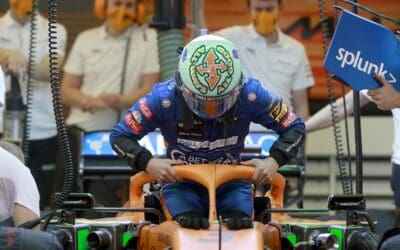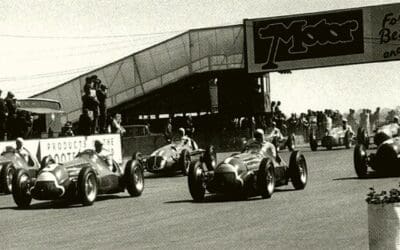The high-octane world of Formula 1 (F1) racing has always been at the forefront of automotive technology, pushing the boundaries of what is possible in car engineering and design. From roaring engines to aerodynamic advancements, F1 has been a spectacular arena where technology and innovation collide at breakneck speeds. “Revving the Engines” invites readers on a thrilling ride through time to explore the pivotal technological leaps that have defined the evolution of F1 cars over the decades. Buckle up, as we navigate the circuits of innovation that have driven F1 to the pinnacle of motorsport.
Chapter 1: The Roots
1950s to 1960s Delve into the origins of F1 racing, where the focus laid heavily on engine capacity and power. Discover the iconic designs and mechanical prowess of the era, understanding how engineers and drivers of the time forged the foundation of modern racing.

Engine Placement:
- In the early 1950s, most Formula 1 cars had their engines placed in the front. However, by the late 1950s and into the 1960s, there was a shift towards rear-engine designs, improving the cars’ handling and balance.
Capacity and Configuration:
- Initially, Formula 1 regulations allowed engines up to 4.5 liters naturally aspirated, or 1.5 liters supercharged.
- Different configurations were used, such as inline-4, inline-6, V8, and V12 engines, each with unique characteristics and benefits.
Fuel and Supercharging:
- The fuel used in these engines was not standardized, leading to a variety of mixtures, including alcohol-based fuels.
- Superchargers were prevalent in the early 1950s but eventually fell out of favor as naturally aspirated engines became more popular.
Innovation and Manufacturers:
- Italian manufacturers like Ferrari and Maserati were highly influential in engine design and innovation.
- British manufacturers like BRM and Coventry Climax also contributed significant advancements, especially in the later part of this period.
Revolution Limit:
- Engines during this period didn’t have the high-revolution limits seen in modern F1. They operated at lower RPMs, but advancements gradually increased the revolution limits.
Power Output:
- Power output varied considerably, with engines producing anywhere from around 200 to 300 horsepower. The variation was due to different engine configurations, supercharging, and fuel mixtures.
Reliability:
- Engines during this era were not as reliable as today’s power units. Failures, overheating, and various mechanical issues were quite common, making durability a critical aspect of races.
Technological Development:
- Technological advancements were not as rapid as in later decades, but continuous improvement and experimentation were key characteristics of this era, laying the groundwork for future developments in F1 engine technology.
Iconic Engines:
- Ferrari’s V12 and Coventry Climax’s inline-4 engines are among the iconic engines from this period, each notable for their unique design and success in races.
Limited Regulations:
- Regulations were not as stringent as in modern F1, allowing manufacturers and teams a bit more freedom to experiment with different technologies and engine designs.
Chapter 2: Aerodynamic Epoch
1970s Embark on a journey through the 1970s, where the wings took flight, and the essence of aerodynamics became the heart of competition. Explore how the newfound focus on downforce and drag revolutionized the racing landscape, defining a new epoch in F1 technology.

Aerodynamic Exploration:
- The 1970s witnessed a deeper exploration of aerodynamics. Cars were designed with sleeker bodies, larger rear wings, and innovative front spoilers to manage airflow, reduce drag, and increase downforce.
Ground Effect Era:
- Teams began to experiment with ‘ground effect’ aerodynamics, utilizing the car’s underbody design to generate downforce, essentially ‘sucking’ the car to the track to improve grip and cornering speed.
Engine Configuration:
- Engines primarily ranged from V8s to V12s, with some teams also experimenting with flat-12 configurations.
- The capacity of naturally aspirated engines during this period was limited to 3.0 liters.
Turbocharging Advent:
- Although turbocharging became more dominant in the 1980s, the technology began to make its appearance in the later part of the 1970s.
- Renault introduced the first turbocharged engine in F1 in 1977, signifying the beginning of a new technological era.

Materials and Cooling:
- Aluminum alloys were commonly used in engine construction, while efforts were also made to improve engine cooling systems due to the increasing power outputs and thermal stresses.
Focus on Fuel Efficiency:
- With the evolving aerodynamics, there was also a subtle shift towards improving fuel efficiency. Engines had to be powerful yet efficient to complement the aerodynamic features of the cars.
Adjustments for Aerodynamics:
- Engine designs and placements were also influenced by aerodynamic considerations. The overall packaging of the engine became crucial to ensure that aerodynamic components, like wings and ground-effect features, worked effectively.
Integration with Chassis:
- Engine integration with the car’s chassis became more sophisticated to ensure that the entire car worked harmoniously to manage downforce and drag.
Variety of Manufacturers:
- Engine manufacturers like Ford-Cosworth, Ferrari, and Renault played significant roles, each bringing unique approaches to engine design and integration with aerodynamic features.
Reliability Concerns:
- With increasing technological advancements, maintaining engine reliability was still a challenge, and many teams faced issues with engine failures and technical problems related to the increased stresses from improved aerodynamics.
Chapter 3: Turbocharged Times
1980s Experience the turbocharged revolution that intensified the spectacle of F1. Learn how turbo engines transformed the racing dynamics, unleashing unprecedented speeds and introducing new challenges and strategies in the engineering of racing cars.
Turbocharging Prowess:
- Turbocharging became predominant during the 1980s. It allowed smaller engines to produce significantly more power by forcing more air into the combustion chambers, thereby increasing efficiency and performance.
Power Output:
- Turbocharged engines in the 1980s could produce over 1000 horsepower in qualifying trim. In race trim, the power was usually around 700-800 horsepower.
Boost Pressure:
- Turbocharged engines ran at very high boost pressures, sometimes exceeding 4.0 bar, especially during qualifying, to extract maximum power.
Engine Configuration and Displacement:
- V6 turbo engines became popular, with a displacement typically around 1.5 liters. Notable manufacturers included Honda, BMW, and Renault.
Fuel Consumption:
- Turbocharged engines were thirsty, requiring strategic fuel management. Fuel capacity was a crucial consideration, given the limit of 220 liters per race by mid-1980s.
Temperature Management:
- Turbocharged engines generated immense heat, requiring advanced cooling systems and materials to manage temperatures and ensure reliability.
Qualifying vs. Race Setup:
- There was a significant difference between qualifying and race setups. “Qualifying engines” with extremely high boost were used to achieve astonishing lap times but had limited reliability.
Technological Innovation:
- The technological race in turbocharging led to rapid innovations in engine management systems, fuel injection, and materials to withstand high pressures and temperatures.
Regulations and Restrictions:
- In response to the high speeds achieved with turbocharging, the FIA introduced regulations such as boost restrictions and fuel flow limits to enhance safety.
Key Teams and Manufacturers:
- Teams like McLaren, Williams, and Ferrari, and engine manufacturers like Honda, BMW, and Renault, were key players in the turbo era, achieving significant success.
Decline of Naturally Aspirated Engines:
- The power and efficiency of turbocharged engines led to a decline in the use of naturally aspirated engines during the mid-to-late 1980s.
Ending the Turbo Era:
- The FIA decided to phase out turbocharged engines by 1989, citing reasons like cost, complexity, and safety, marking the end of a significant chapter in F1 history.

Chapter 4: Electronics and Computers
Navigate the circuits of the 1990s, where electronic systems and semi-automatic gearboxes started to permeate F1 engineering. Unpack the influence of technology on strategies, race control, and car management, heralding an era of precision and technological synchronization.
Engine Specifications:
- The early 1990s saw the last of the turbocharged engines, transitioning to naturally aspirated engines.
- V10 and V12 engines became prominent, with a displacement of 3.5 liters initially, reduced to 3.0 liters in 1995.

RPM and Power Output:
- Engines in the 1990s revved higher than before, some reaching over 15,000 RPM.
- Power outputs ranged from 600 to 800 horsepower, with variations depending on engine configuration and team.
Electronic Innovations:
- Semi-automatic transmissions and paddle shifters became standard, improving gearshift efficiency and driver focus.
- Traction control systems, active suspensions, and anti-lock braking systems (ABS) were introduced but later banned due to controversies over ‘driver aids’.
Fuel and Efficiency:
- Fuel efficiency became crucial due to refueling being banned in 1994 (reintroduced in 1994 and then banned again in 2010).
- Teams and engine manufacturers worked closely to optimize fuel consumption and engine performance.
Weight Considerations:
- Engine weight and its distribution became a crucial aspect of car design, impacting handling and performance.
Materials and Construction:
- Advanced materials like carbon fiber, titanium, and various alloys became integral in engine construction and chassis design to enhance durability and reduce weight.
Manufacturer Involvement:
- Manufacturers such as Renault, Ferrari, Mercedes, and Honda played pivotal roles in engine supply and development.
- Manufacturer partnerships with teams became increasingly significant, influencing design, technology, and overall competitiveness.
Aerodynamic Evolution:
- Aerodynamics continued to evolve, with a focus on wing design, diffusers, and bargeboards to manage airflow, downforce, and drag.
Reliability:
- Engine reliability improved significantly, with fewer mechanical retirements and better overall durability across the season.
Regulations:
- Regulatory changes impacted engine design and usage, including limitations on RPM, changes in displacement, and restrictions on electronic systems.

Chapter 5: Hybrid Horizons
2000s to 2010s Witness the advent of hybrid technology, where F1 became a testbed for sustainable and efficient automotive innovations. Explore the integration of energy recovery systems and the advancement towards a greener and more technologically sophisticated grid.
KERS Introduction (2009):
- Kinetic Energy Recovery Systems (KERS) were introduced in 2009. These systems captured energy during braking, storing it for later use to provide a temporary power boost, signifying the sport’s first steps towards hybridization.

Turbo-Hybrid Power Units (2014 onwards):
- In 2014, F1 moved to 1.6-liter V6 turbocharged hybrid power units, combining internal combustion engines with potent electrical components for hybrid energy recovery and deployment.

Energy Recovery Systems (ERS):
- ERS became a vital component, recovering energy from both braking and the heat produced by the turbocharger, which could be stored and used to enhance power and efficiency.
Power Output and Efficiency:
- The combined power output from the internal combustion engine and electrical systems reached around 1000 horsepower.
- These power units achieved thermal efficiencies of over 50%, a significant improvement compared to previous engine formats.
Components and Complexity:
- The hybrid power units were complex assemblies involving the internal combustion engine, MGU-K (Motor Generator Unit-Kinetic), MGU-H (Motor Generator Unit-Heat), energy store (batteries), and turbocharger.
Regulations and Limitations:
- Strict regulations governed fuel flow rates, maximum fuel allowance, and the deployment of stored electrical energy, enforcing technological advancements in efficiency and energy recovery.
Manufacturer Involvement:
- Manufacturers like Mercedes, Ferrari, and Renault were pivotal in developing and supplying the new hybrid power units, with Honda rejoining the sport in 2015.
Reliability and Durability:
- The durability of power unit components was crucial, with regulations limiting the number of each component that could be used in a season without incurring penalties.
Environmental Considerations:
- The move towards hybrid power units aligned with global trends towards sustainability and reduced emissions, making F1 more relevant as a platform for developing and showcasing advanced automotive technologies.
Technological Innovation:
- The hybrid era sparked intensive technological innovation and competition, as teams and manufacturers sought to optimize performance, reliability, and efficiency within the regulatory constraints.
Success and Dominance:
- Certain manufacturers, particularly Mercedes, found considerable success in mastering the complexities of the hybrid power units, influencing competitive dynamics and team performance in the hybrid era.
Chapter 6: Into the Future – 2020s and Beyond
The most recent advancements in Formula 1 technology underscore a relentless pursuit of aerodynamic optimization and hybrid power unit enhancement. Leading this innovation crusade are cutting-edge aerodynamic concepts such as the ground-effect floors and simplified front wings, aimed at improving car following and overtaking. These design changes foster closer racing by mitigating the aerodynamic turbulence affecting trailing cars.

On the power unit frontier, manufacturers like Mclaren, Mercedes, Ferrari, Red Bull Racing (with their powertrain division), and Renault continuously refine their hybrid technology, pushing boundaries of thermal efficiency and energy recovery. A notable focus lies in maximizing the performance of the ERS (Energy Recovery System), which harvests energy during braking and heat from the engine, symbolizing a synergy of performance and sustainability.
Looking ahead, F1 seems poised to navigate towards a net-zero carbon footprint, further aligning with global sustainability goals. The incorporation of sustainable fuels, advancements in synthetic fuels, and exploration of biofuel options also delineate the roadmap, with the potential to revolutionize the sport’s ecological impact and technological relevance in the broader automotive industry.






